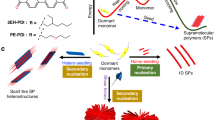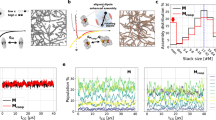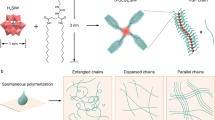Abstract
Developing new generic methodologies for organizing molecules into nano- to mesoscale structures of precise shapes and sizes is a research topic at the forefront of modern chemistry. Creating hierarchical molecular assembly, especially at the mesoscale, is important to realize functions reminiscent of those manifested by biomolecular assemblies in the mesoscopic regime. However, this is challenging due to the difficulty in maintaining stringent controllability over the organization of molecules at higher hierarchical levels, wherein weak non-directional intermolecular interactions rather than strong directional interactions typically play a predominant role. Recent studies have revealed that secondary nucleation, often experienced by one-dimensional assemblies such as supramolecular polymers that grow with spontaneous nucleation, is effective in the hierarchical construction of higher-order structures. Here we illustrate how secondary nucleation can be combined with the well-established precision synthesis of supramolecular polymers to realize precise control over hierarchical structures in the mesoscopic regime. We present a roadmap for creating hierarchical supramolecular polymers by exploiting secondary nucleation–elongation processes and discuss future prospects for the field.

This is a preview of subscription content, access via your institution
Access options
Access Nature and 54 other Nature Portfolio journals
Get Nature+, our best-value online-access subscription
$32.99 / 30 days
cancel any time
Subscribe to this journal
Receive 12 print issues and online access
$259.00 per year
only $21.58 per issue
Buy this article
- Purchase on SpringerLink
- Instant access to full article PDF
Prices may be subject to local taxes which are calculated during checkout







Similar content being viewed by others
References
Saper, G. & Hess, H. Synthetic systems powered by biological molecular motors. Chem. Rev. 120, 228–309 (2020).
Iino, R., Kinbara, K. & Bryant, Z. Introduction: molecular motors. Chem. Rev. 120, 1–4 (2020).
Mirkovic, T. et al. Light absorption and energy transfer in the antenna complexes of photosynthetic organisms. Chem. Rev. 117, 249–293 (2017).
Cogdell, R. J., Gall, A. & Köhler, J. The architecture and function of the light-harvesting apparatus of purple bacteria: from single molecules to in vivo membranes. Q. Rev. Biophys. 39, 227–324 (2006).
Cogdell, R. J. et al. The structural basis of light-harvesting in purple bacteria. FEBS Lett. 555, 35–39 (2003).
Gong, Y. et al. Unprecedented small molecule-based uniform two-dimensional platelets with tailorable shapes and sizes. J. Am. Chem. Soc. 144, 15403–15410 (2022).
Percec, V. et al. Controlling polymer shape through the self-assembly of dendritic side-groups. Nature 391, 161–164 (1998).
Chen, G. et al. Supramolecular hexagonal platelet assemblies with uniform and precisely-controlled dimensions. J. Am. Chem. Soc. 141, 15498–15503 (2019).
Ishiwari, F., Shoji, Y. & Fukushima, T. Supramolecular scaffolds enabling the controlled assembly of functional molecular units. Chem. Sci. 9, 2028–2041 (2018).
Fujita, D. et al. Self-assembly of M30L60 icosidodecahedron. Chem 1, 91–101 (2016).
Fukui, T. et al. Control over differentiation of a metastable supramolecular assembly in one and two dimensions. Nat. Chem. 9, 493–499 (2017).
Ogi, S., Sugiyasu, K., Manna, S., Samitsu, S. & Takeuchi, M. Living supramolecular polymerization realized through a biomimetic approach. Nat. Chem. 6, 188–195 (2014).
Gilroy, J. B. et al. Monodisperse cylindrical micelles by crystallization-driven living self-assembly. Nat. Chem. 2, 566–570 (2010).
Wang, X. et al. Cylindrical block copolymer micelles and co-micelles of controlled length and architecture. Science 317, 644–647 (2007).
Aida, T., Meijer, E. W. & Stupp, S. I. Functional supramolecular polymers. Science 335, 813–817 (2012).
De Greef, T. F. A. et al. Supramolecular polymerization. Chem. Rev. 109, 5687–5754 (2009).
Chen, Z., Lohr, A., Saha-Möller, C. R. & Würthner, F. Self-assembled π-stacks of functional dyes in solution: structural and thermodynamic features. Chem. Soc. Rev. 38, 564–584 (2009).
Mukhopadhyay, R. D. & Ajayaghosh, A. Living supramolecular polymerization. Science 349, 241–242 (2015).
Ogi, S., Stepanenko, V., Sugiyasu, K., Takeuchi, M. & Würthner, F. Mechanism of self-assembly process and seeded supramolecular polymerization of perylene bisimide organogelator. J. Am. Chem. Soc. 137, 3300–3307 (2015).
Ogi, S., Stepanenko, V., Thein, J. & Würthner, F. Impact of alkyl spacer length on aggregation pathways in kinetically controlled supramolecular polymerization. J. Am. Chem. Soc. 138, 670–678 (2016).
Kang, J. et al. A rational strategy for the realization of chain-growth supramolecular polymerization. Science 347, 646–651 (2015).
Törnquist, M. et al. Secondary nucleation in amyloid formation. Chem. Commun. 54, 8667–8684 (2018).
Szczepankiewicz, O. et al. N-terminal extensions retard Aβ42 fibril formation but allow cross-seeding and coaggregation with Aβ42. J. Am. Chem. Soc. 137, 14673–14685 (2015).
Buell, A. K. et al. Solution conditions determine the relative importance of nucleation and growth processes in α-synuclein aggregation. Proc. Natl Acad. Sci. USA 111, 7671–7676 (2014).
Cohen, S. I. A. et al. Proliferation of amyloid-β42 aggregates occurs through a secondary nucleation mechanism. Proc. Natl Acad. Sci. USA 110, 9758–9763 (2013).
Cartwright, J. H. E., García-Ruiz, J. M., Piro, O., Sainz-Díaz, C. I. & Tuval, I. Chiral symmetry breaking during crystallization: an advection-mediated nonlinear autocatalytic process. Phys. Rev. Lett. 93, 035502 (2004).
Cohen, S. I. A. et al. Distinct thermodynamic signatures of oligomer generation in the aggregation of the amyloid-β peptide. Nat. Chem. 10, 523–531 (2018).
Zhang, D. et al. Control of crystal properties in a mixed-suspension mixed-product removal crystallizer: general methods and the effects of secondary nucleation. Cryst. Growth Des. 19, 3070–3084 (2019).
Besenhard, M. O., Neugebauer, P., Ho, C.-D. & Khinast, J. G. Crystal size control in a continuous tubular crystallizer. Cryst. Growth Des. 15, 1683–1691 (2015).
Qian, R.-Y. & Botsaris, G. D. A new mechanism for nuclei formation in suspension crystallizers: the role of interparticle forces. Chem. Eng. Sci. 52, 3429–3440 (1997).
Xu, S., Hou, Z., Chuai, X. & Wang, Y. Overview of secondary nucleation: from fundamentals to application. Ind. Eng. Chem. Res. 59, 18335–18356 (2020).
Kondepudi, D. K. & Asakura, K. Chiral autocatalysis, spontaneous symmetry breaking, and stochastic behavior. Acc. Chem. Res. 34, 946–954 (2001).
Kondepudi, D. K., Laudadio, J. & Asakura, K. Chiral symmetry breaking in stirred crystallization of 1,1′-binaphthyl melt. J. Am. Chem. Soc. 121, 1448–1451 (1999).
Qian, R.-Y. & Botsaris, G. D. Nuclei breeding from a chiral crystal seed of NaClO3. Chem. Eng. Sci. 53, 1745–1756 (1998).
Kondepudi, D. K., Kaufman, R. J. & Singh, N. Chiral symmetry breaking in sodium chlorate crystallization. Science 250, 975–976 (1990).
Noorduin, W. L. et al. Enantioselective symmetry breaking directed by the order of process steps. Angew. Chem. Int. Ed. 49, 2539–2541 (2010).
Noorduin, W. L. et al. Emergence of a single solid chiral state from a nearly racemic amino acid derivative. J. Am. Chem. Soc. 130, 1158–1159 (2008).
Azeroual, S. et al. Mirror symmetry breaking and chiral amplification in foldamer-based supramolecular helical aggregates. Chem. Commun. 48, 2292–2294 (2012).
Wolffs, M. et al. The role of heterogeneous nucleation in the self-assembly of oligothiophenes. Chem. Commun. 2008, 4613–4615 (2008).
Stals, P. J. M. et al. Symmetry breaking in the self-assembly of partially fluorinated benzene-1,3,5-tricarboxamides. Angew. Chem. Int. Ed. 51, 11297–11301 (2012).
Datta, S. et al. Self-assembled poly-catenanes from supramolecular toroidal building blocks. Nature 583, 400–405 (2020).
Meisl, G. et al. Molecular mechanisms of protein aggregation from global fitting of kinetic models. Nat. Protoc. 11, 252–272 (2016).
Cohen, S. I. A., Vendruscolo, M., Dobson, C. M. & Knowles, T. P. J. From macroscopic measurements to microscopic mechanisms of protein aggregation. J. Mol. Biol. 421, 160–171 (2012).
Sarkar, S., Sarkar, A., Som, A., Agasti, S. S. & George, S. J. Stereoselective primary and secondary nucleation events in multicomponent seeded supramolecular polymerization. J. Am. Chem. Soc. 143, 11777–11787 (2021).
Powers, E. T. & Powers, D. L. The kinetics of nucleated polymerizations at high concentrations: amyloid fibril formation near and above the “supercritical concentration”. Biophys. J. 91, 122–132 (2006).
Smulders, M. M. J., Schenning, A. P. H. J. & Meijer, E. W. Insight into the mechanisms of cooperative self-assembly: the “sergeants-and-soldiers” principle of chiral and achiral C3-symmetrical discotic triamides. J. Am. Chem. Soc. 130, 606–611 (2008).
Stals, P. J. M., Smulders, M. M. J., Martín-Rapún, R., Palmans, A. R. A. & Meijer, E. W. Asymmetrically substituted benzene-1,3,5-tricarboxamides: self-assembly and odd–even effects in the solid state and in dilute solution. Chem. Eur. J. 15, 2071–2080 (2009).
Levin, A. et al. Ostwald’s rule of stages governs structural transitions and morphology of dipeptide supramolecular polymers. Nat. Commun. 5, 5219 (2014).
Kulkarni, C., Meijer, E. W. & Palmans, A. R. A. Cooperativity scale: a structure–mechanism correlation in the self-assembly of benzene-1,3,5-tricarboxamides. Acc. Chem. Res. 50, 1928–1936 (2017).
Šlęczkowski, M. L., Mabesoone, M. F. J., Šlęczkowski, P., Palmans, A. R. A. & Meijer, E. W. Competition between chiral solvents and chiral monomers in the helical bias of supramolecular polymers. Nat. Chem. 13, 200–207 (2021).
Jonkheijm, P., van der Schoot, P., Schenning, A. P. H. J. & Meijer, E. W. Probing the solvent assisted nucleation pathway in chemical self-assembly. Science 313, 80–83 (2006).
Anwar, J., Khan, S. & Lindfors, L. Secondary crystal nucleation: nuclei breeding factory uncovered. Angew. Chem. Int. Ed. 54, 14681–14684 (2015).
Pal, T. & Chaudhuri, D. Chiral and morphological anisotropy of supramolecular polymers shaped by a singularity in solvent composition. J. Am. Chem. Soc. 145, 2532–2543 (2023).
Meisl, G. et al. Differences in nucleation behavior underlie the contrasting aggregation kinetics of the Aβ40 and Aβ42 peptides. Proc. Natl Acad. Sci. USA 111, 9384–9389 (2014).
Khanra, P., Singh, A. K., Roy, L. & Das, A. Pathway complexity in supramolecular copolymerization and blocky star copolymers by a hetero-seeding effect. J. Am. Chem. Soc. 145, 5270–5284 (2023).
Gao, Y. et al. Bead-string-shaped DNA nanowires with intrinsic structural advantages and their potential for biomedical applications. ACS Appl. Mater. Interfaces 12, 3341–3353 (2020).
Bairagi, D. et al. Self-assembling peptide-based hydrogel: regulation of mechanical stiffness and thermal stability and 3D culture of fibroblasts. ACS Appl. Bio Mater. 2, 5235–5244 (2019).
Freire, F., Quiñoá, E. & Riguera, R. Supramolecular assemblies from poly(phenylacetylene)s. Chem. Rev. 116, 1242–1271 (2016).
Xing, P., Chen, H., Bai, L., Hao, A. & Zhao, Y. Superstructure formation and topological evolution achieved by self-organization of a highly adaptive dynamer. ACS Nano 10, 2716–2727 (2016).
Cai, X. et al. Mechano-responsive calix[4]arene-based molecular gels: agitation induced gelation and hardening. Soft Matter 9, 5807–5814 (2013).
Horvath, I., Kumar, R. & Wittung-Stafshede, P. Macromolecular crowding modulates α-synuclein amyloid fiber growth. Biophys. J. 120, 3374–3381 (2021).
Sakunthala, A. et al. Direct demonstration of seed size-dependent α-synuclein amyloid amplification. J. Phys. Chem. Lett. 13, 6427–6438 (2022).
Bäumer, N., Castellanos, E., Soberats, B. & Fernández, G. Bioinspired crowding directs supramolecular polymerisation. Nat. Commun. 14, 1084 (2023).
Osypenko, A. et al. Temperature control of sequential nucleation–growth mechanisms in hierarchical supramolecular polymers. Chem. Eur. J. 25, 13008–13016 (2019).
Fukui, T., Sasaki, N., Takeuchi, M. & Sugiyasu, K. Living supramolecular polymerization based on reversible deactivation of a monomer by using a ‘dummy’ monomer. Chem. Sci. 10, 6770–6776 (2019).
Yamauchi, M. et al. Supramolecular polymerization of supermacrocycles: effect of molecular conformations on kinetics and morphology. Chem. Eur. J. 23, 5270–5280 (2017).
Yagai, S. et al. Supramolecularly engineered aggregation of a dipolar dye: vesicular and ribbonlike architectures. Angew. Chem. Int. Ed. 49, 9910–9994 (2010).
Törnquist, M. & Linse, S. Chiral selectivity of secondary nucleation in amyloid fibril propagation. Angew. Chem. Int. Ed. 60, 24008–24011 (2021).
Sarkar, S., Sarkar, A. & George, S. J. Stereoselective seed-induced living supramolecular polymerization. Angew. Chem. Int. Ed. 59, 19841–19845 (2020).
Sarkar, S., Laishram, S., Deb, D. & George, S. J. Controlled noncovalent synthesis of secondary supramolecular polymers. J. Am. Chem. Soc. 145, 22009–22018 (2023).
Roche, C. et al. A supramolecular helix that disregards chirality. Nat. Chem. 8, 80–89 (2016).
Wehner, M. & Würthner, F. Supramolecular polymerization through kinetic pathway control and living chain growth. Nat. Rev. Chem. 4, 38–53 (2020).
Wehner, M. et al. Supramolecular polymorphism in one-dimensional self-assembly by kinetic pathway control. J. Am. Chem. Soc. 141, 6092–6107 (2019).
Datta, S., Takahashi, S. & Yagai, S. Nanoengineering of curved supramolecular polymers: toward single-chain mesoscale materials. Acc. Mater. Res. 3, 259–271 (2022).
Yagai, S., Kitamoto, Y., Datta, S. & Adhikari, B. Supramolecular polymers capable of controlling their topology. Acc. Chem. Res. 52, 1325–1335 (2019).
Yagai, S., Goto, Y., Karatsu, T., Kitamura, A. & Kikkawa, Y. Catenation of self-assembled nanorings. Chem. Eur. J. 17, 13657–13660 (2011).
Baluna, A. S. et al. In search of Wasserman’s catenane. J. Am. Chem. Soc. 145, 9825–9833 (2023).
Wasserman, E. Chemical topology. Sci. Am. 207, 94–102 (1962).
Wasserman, E. The preparation of interlocking rings: a catenane. J. Am. Chem. Soc. 82, 4433–4434 (1960).
Dietrich-Buchecker, C. O., Sauvage, J. P. & Kintzinger, J. P. Une nouvelle famille de molecules: les metallo-catenanes. Tetrahedron Lett. 24, 5095–5098 (1983).
Itabashi, H., Tashiro, K., Koshikawa, S., Datta, S. & Yagai, S. Distinct seed topologies enable comparison of elongation and secondary nucleation pathways in seeded supramolecular polymerization. Chem. Commun. 59, 7375–7378 (2023).
Wu, Q. et al. Poly[n]catenanes: synthesis of molecular interlocked chains. Science 358, 1434–1439 (2017).
Itabashi, H., Datta, S., Tsukuda, R., Hollamby, M. J. & Yagai, S. Fine-tuning of the size of supramolecular nanotoroids suppresses the subsequent catenation of nano-[2]catenane. Chem. Sci. 14, 3270–3276 (2023).
Sasaki, N. et al. Supramolecular double-stranded Archimedean spirals and concentric toroids. Nat. Commun. 11, 3578 (2020).
Sasaki, N. et al. Multistep, site-selective noncovalent synthesis of two-dimensional block supramolecular polymers. Nat. Chem. 15, 922–929 (2023).
Draper, E. R. & Adams, D. J. Low-molecular-weight gels: the state of the art. Chem 3, 390–410 (2017).
Kouwer, P. H. J. et al. Responsive biomimetic networks from polyisocyanopeptide hydrogels. Nature 493, 651–655 (2013).
Terech, P. & Weiss, R. G. Low molecular mass gelators of organic liquids and the properties of their gels. Chem. Rev. 97, 3133–3160 (1997).
Laishram, R. et al. Secondary nucleation-triggered physical cross-links and tunable stiffness in seeded supramolecular hydrogels. J. Am. Chem. Soc. 144, 11306–11315 (2022).
Hay, J. N. Secondary crystallization kinetics. Polym. Cryst. 1, e10007 (2018).
Chiu, H.-J. Spherulitic morphology and crystallization kinetics of poly (vinylidene fluoride)/poly (vinyl acetate) blends. J. Polym. Res. 9, 169–174 (2002).
Avrami, M. Kinetics of phase change. I General theory. J. Chem. Phys. 7, 1103–1112 (1939).
Singh, N., Lopez-Acosta, A., Formon, G. J. M. & Hermans, T. M. Chemically fueled self-sorted hydrogels. J. Am. Chem. Soc. 144, 410–415 (2022).
Karunakaran, S. C. et al. Exquisite regulation of supramolecular equilibrium polymers in water: chain stoppers control length, polydispersity and viscoelasticity. Polym. Chem. 9, 5268–5277 (2018).
Kubota, R., Tanaka, W. & Hamachi, I. Microscopic imaging techniques for molecular assemblies: electron, atomic force, and confocal microscopies. Chem. Rev. 121, 14281–14347 (2021).
Fukui, T. et al. Direct observation and manipulation of supramolecular polymerization by high-speed atomic force microscopy. Angew. Chem. Int. Ed. 57, 15465–15470 (2018).
Van Ewijk, C. et al. Light-triggered disassembly of molecular motor-based supramolecular polymers revealed by high-speed AFM. Angew. Chem. Int. Ed. 63, e202319387 (2024).
Watanabe-Nakayama, T. et al. High-speed atomic force microscopy reveals structural dynamics of amyloid β1–42 aggregates. Proc. Natl Acad. Sci. USA 113, 5835–5840 (2016).
Thacker, D., Barghouth, M., Bless, M., Zhang, E. & Linse, S. Direct observation of secondary nucleation along the fibril surface of the amyloid β42 peptide. Proc. Natl Acad. Sci. USA 120, e2220664120 (2023).
Acknowledgements
This work was supported by the Japan Society for the Promotion of Science (KAKENHI grants JP22H00331 and JP23H04873 to S.Y. and JP22K20526 to S.D.) as part of the Grant-in-Aid for Transformative Research Areas project Materials Science of Meso-Hierarchy. H.I. and T.S. each acknowledge the Japan Society for the Promotion of Science for a Research Fellowship for Young Scientists (24KJ0529 and 21J20988, respectively).
Author information
Authors and Affiliations
Contributions
S.D. and S.Y. wrote the manuscript. All authors contributed to discussions and creation of the figures.
Corresponding authors
Ethics declarations
Competing interests
The authors declare no competing interests.
Peer review
Peer review information
Nature Chemistry thanks the anonymous reviewers for their contribution to the peer review of this work.
Additional information
Publisher’s note Springer Nature remains neutral with regard to jurisdictional claims in published maps and institutional affiliations.
Rights and permissions
Springer Nature or its licensor (e.g. a society or other partner) holds exclusive rights to this article under a publishing agreement with the author(s) or other rightsholder(s); author self-archiving of the accepted manuscript version of this article is solely governed by the terms of such publishing agreement and applicable law.
About this article
Cite this article
Datta, S., Itabashi, H., Saito, T. et al. Secondary nucleation as a strategy towards hierarchically organized mesoscale topologies in supramolecular polymerization. Nat. Chem. 17, 477–492 (2025). https://doi.org/10.1038/s41557-025-01764-5
Received:
Accepted:
Published:
Issue date:
DOI: https://doi.org/10.1038/s41557-025-01764-5



